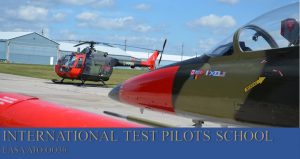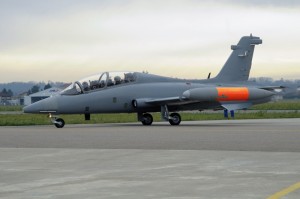SHAH ALAM: FLIT overseas. It appears that a small number RMAF personnel are being trained to become fighter pilots in Ontario, Canada. This is a departure from the normal Fighter Lead In Training (FLIT) programme conducted at Pulatibang 3 at the Kuantan airbase. The training at the International Test Pilots School (ITPS), London, Ontario was reported by the CBC on May 22.
If you’ve seen fighter jets over the city recently, it’s because a London company is training fighter pilots for the Malaysian Air Force and they’re practicing everything from combat to tactical manoeuvring.
And while they’re not taking up any more airspace than they normally do, the lack of commercial flights and recent renovations on a London International Airport runway have made the loud fighter jets more noticeable than ever.
“They’re practicing aircraft-to-aircraft combat, aircraft-to-ground combat, and aerobatics,” said Giorgio Clementi, the owner of ITPS Canada, which he established here in London in 2009.
“Top Gun is a couple of notches above what we do, but eventually these pilots will go back to their home countries and become the top guns for their air forces.
The second part of the business trains fighter pilots. The London company gets contracts from foreign governments and eventually gets them flying on five jet trainers. The model is an Aero L39 Albatros.
“It’s one of the most popular jet trainers in the world,” said Clementi. “We basically take pilots who can fly a propeller airplane train them to be fighter pilots. We give them all the fundamentals that they need.”


I had delayed writing about the post as I had been trying to get more details about the programme but unfortunately it remained sketchy. The number of trainee pilots being trained with ITPS Canada – International Test Pilots School – is likely around four to six. RMAF FLIT programme consisted of two parts – Basic Jet and Advanced Jet training – usually takes in four to six trainee pilots per year.

Those who passed both parts – around 12 months for each course – will be assigned to the four fighter squadrons – namely No. 12 Squadron at Gong Kedak; No 18 and No. 15 squadrons at Butterworth and No. 6 at Labuan for conversion training and operational qualifications. RMAF dont have a squadron for operational conversion training as it has small number of fighter types compared to the other air forces like the UK and US.
As Malaysian Defence had reported previously the FLIT programme had come under pressure during the last decade as the MB-339CM trainer at Pulatibang 3 did not aged gracefully, resulting in delays in qualifying new pilots for the fighter squadrons.
The training in Canada, I was told, was an extension of an existing contract between local firm, Inisiatif Hati Sdn Bhd and RMAF to conduct pilot training – mostly for experience pilots – with ITPS. AFAIK this was the second time FLIT was conducted overseas, the first was with Pakistan Air Force around 2006, prior to the delivery of the CMs. I was told that colloboration (G-to-G) was stopped after one intake as I was told that the RMAF felt that the pilots who graduated from there did not meet expectations.
The first batch of RMAF trainees, 10, started training at ITPS in January this year with the second batch later this year. It is likely that the second batch training will be postponed until the travel restrictions imposed by coronavirus pandemic are eased.
-Malaysian Defence
If you like this post, buy me an espresso. Paypal Payment

View Comments (26)
@ marhalim
The contract for this year seems to be for 18 fighter pilots.
The 1st batch is for 8 pilots (completed around february-march), the 2nd batch (not yet started) is for 10 pilots.
The 1st batch was trained on 3x Aero L-39C and a single Aero L-29 jet trainer. IPTS has bought a total of 5 L-39C and 2 L-29 to train the malaysian pilots. Actually IPTS created a new section of the company especially for this, called the International Tactical Training Center.
http://assets.skiesmag.com/wp-content/uploads/2020/02/itps2020260192.jpg
The details of the jet trainers from OSINT (Open-source intelligence)
Aero L-39C (tail number below)
1) N915WE
2) C-GTOZ - with Garmin G3X touchscreen display cockpit
3) N88EA
4) C-GFNO
5) N??? (white and yellow livery)
Aero L-29 (tail number below)
1) C-FLVB
2) C-FXZI ex-N8164C
Basically this FLIT training overseas is a confirmation that our MB-339CM is no longer flyable. Actually with regards to the quality of training, this is IMO a step back from even the MB-339CM, as the aermacchi has a dedicated military glass cockpit instrumentation and a dedicated simulator, while the L-39C of ITPS is a hodgepodge of different cockpit modification on each aircraft, slow reaction time of the Ivchenko AI-25TL engine and no dedicated simulator. If we move on to the TA-50, the LIFT training module will be vastly superior to both, with embedded training, carefree fly by wire handling and comprehensive ground training devices.
Can RMAF's MB339CM equipped with unguided rockets and bombs for light attack like BAE Hawk?
Reply
Yes
Possibly a train-the-trainer program, for them to take back and train the Pulatibang guys? "these pilots will go back to their home countries and become the top guns for their air forces"
Reply
No lah its basic and advanced jet training, read the whole story from the link. I cannot be copying and pasting from another website.
Its probably cheaper to outsource pur pilot trainning too. The British n everyone else send their pilot for trainning in Canada as its much much cheaper n more egficient rather than doing it in house
The MBB-339As were equipped with 2.75in rockets, 30mm pods and 250kg bombs. No idea if we’ve armed the CMs.
We had previously awarded this company contracts to train our pilots in fighter tactics. The actual air training was done here but classroom instruction was in Canada - graduates wore a patch on their flight suits.
Where the hell is the money?
After the Nuris are grounded with no replacement, now it almost certain that.the MB-339C are not flying too.
No money for maintenance and replacement. What are they doing to RMAF?
Reply
Not really, they would have gotten approval from the defence and finance ministries to use the money to operate the CMs to fund the training overseas. Its the same like the Nuri grounding, the funds to operate them will be used to pay for the leasing of new helicopters.
May I ask if the MB-339 CMs are not utilised for the LIFT, what are they currently used for now? I’m worried that the RMAF’s limited funds are still being used on the aircraft when its role are no longer effective
Reply
They are not in service AFAIK
@ lee yoke meng
british and everyone else?
The Brits do have their own LIFT training in-country with 28 Hawk 128.
http://i2-prod.dailypost.co.uk/incoming/article16911030.ece/ALTERNATES/s1200b/1_Vote-for-your-favourite-photo-in-the-Royal-Air-Forces-annual-photography-competition-kindly-sponso.jpg
Having aircraft to do LIFT in-country will be advantageous as these can also be used in a crisis, unlike contracted overseas training.
Azlan "No idea if we’ve armed the CMs. "
Yes, they've been exhibited with combined gun and rocket pods.
Lee - “Its probably cheaper to outsource pur pilot trainning too””
Pros and cons.
Ultimately we need the ability to be able to conduct such training locally without being dependent on external help. No doubts here.
The plus side is that having such training conducted abroad ensures our pilots get to train and interact with instructors (foreign) who have more exposure and experience compared to local instructors; virtue of the fact that these instructors were from NATO air arms and likely have a actual operational experience.